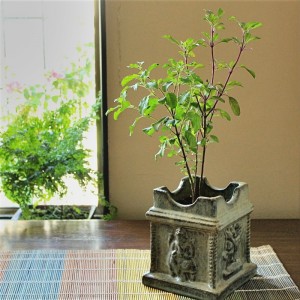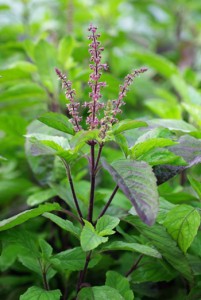
The tulasi plant is a small perennial shrub in the mint family that is native to India and which is venerated by Hindus in general and Vaishnavas in particular. The botanical name is ocimum tenuiflorum or sometimes, ocimum sanctum, the sacred Basil. In Hindi and other north Indian languages the name is written just a tulsi.

There are three varieties of tulasi plants used by Hindus. There is a dark variety called syama or krishna tulasi, a white variety called rama tulasi, and an extremely hardy variety sometimes called Fujian or Thai tulasi. Many orthodox Vaishnavas do not accept this latter tulasi as true tulasi although this variety is the most common of all since it is easiest to grow. This Thai tulasi is distinguished from the two former varieties because it is much larger. The syama or krishna tulasi is the smallest variety and is the most difficult to grow.
No Hindu home is considered complete without a tulasi plant. Mostly, the tulasi is grown directly in the ground, but sometimes it is grown in a special container that allows places for lamps. See the illustration to the left. Vaishnavas worship tulasi as the Goddess Lakshmi, the consort of Vishnu and so during puja, tulasi leaves are offered to the feet of Vishnu. Lakshmi is the wife of Vishnu and so the offering of tulasi leaves is the offering of love. Tulasi leaves are also dipped in sandal paste and stuck to the feet of Vishnu during puja.
 Vaishnavas carve the wood of the tulasi plant and use it for chanting beads (japa mala). It is also common to see small tulasi beads worn in strands around the neck. During the month of Kartika (October-November) a ceremony called tulasi vivaha is commonly celebrated, This is a wedding ceremony where tulusi is “married” to Vishnu or Krishna. Sometimes Vishnu comes in the form of a sacred stone (shalagram shila), so it is interesting to see a marriage between a plant and a stone! You can imagine how strange this seemed to the British when they saw such a ritual in temples without a clear explanation of what was going on. The tulasi plant is fully decorated with a wedding sari, jewelry, and sometimes even a face made of silver or hardened wheat dough. It is a fun ceremony to watch as the “parents” of both the bride and groom proudly carry their son and daughter through the paces of the marriage ceremony.
Vaishnavas carve the wood of the tulasi plant and use it for chanting beads (japa mala). It is also common to see small tulasi beads worn in strands around the neck. During the month of Kartika (October-November) a ceremony called tulasi vivaha is commonly celebrated, This is a wedding ceremony where tulusi is “married” to Vishnu or Krishna. Sometimes Vishnu comes in the form of a sacred stone (shalagram shila), so it is interesting to see a marriage between a plant and a stone! You can imagine how strange this seemed to the British when they saw such a ritual in temples without a clear explanation of what was going on. The tulasi plant is fully decorated with a wedding sari, jewelry, and sometimes even a face made of silver or hardened wheat dough. It is a fun ceremony to watch as the “parents” of both the bride and groom proudly carry their son and daughter through the paces of the marriage ceremony.
The tulasi plant also has many medicinal properties. Extracts from tulasis are used in traditional Ayurvedic medicines for common colds, headaches, stomach problems and even heart problems. Preparations of tulasi are often made into a tea or a powder or even just eaten as fresh leaves along with ghee, clarified butter.